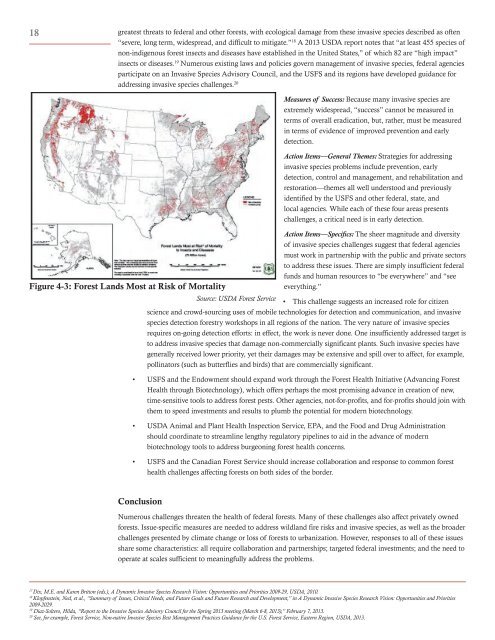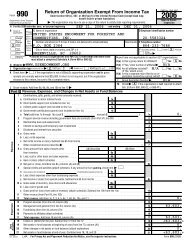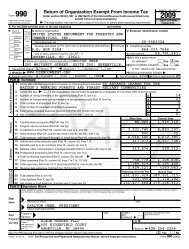The State and Future of U.S. Forestry and the Forest Industry (May ...
The State and Future of U.S. Forestry and the Forest Industry (May ...
The State and Future of U.S. Forestry and the Forest Industry (May ...
Create successful ePaper yourself
Turn your PDF publications into a flip-book with our unique Google optimized e-Paper software.
18 greatest threats to federal <strong>and</strong> o<strong>the</strong>r forests, with ecological damage from <strong>the</strong>se invasive species described as <strong>of</strong>ten“severe, long term, widespread, <strong>and</strong> difficult to mitigate.” 18 A 2013 USDA report notes that “at least 455 species <strong>of</strong>non-indigenous forest insects <strong>and</strong> diseases have established in <strong>the</strong> United <strong>State</strong>s,” <strong>of</strong> which 82 are “high impact”insects or diseases. 19 Numerous existing laws <strong>and</strong> policies govern management <strong>of</strong> invasive species, federal agenciesparticipate on an Invasive Species Advisory Council, <strong>and</strong> <strong>the</strong> USFS <strong>and</strong> its regions have developed guidance foraddressing invasive species challenges. 20Measures <strong>of</strong> Success: Because many invasive species areextremely widespread, “success” cannot be measured interms <strong>of</strong> overall eradication, but, ra<strong>the</strong>r, must be measuredin terms <strong>of</strong> evidence <strong>of</strong> improved prevention <strong>and</strong> earlydetection.Action Items—General <strong>The</strong>mes: Strategies for addressinginvasive species problems include prevention, earlydetection, control <strong>and</strong> management, <strong>and</strong> rehabilitation <strong>and</strong>restoration—<strong>the</strong>mes all well understood <strong>and</strong> previouslyidentified by <strong>the</strong> USFS <strong>and</strong> o<strong>the</strong>r federal, state, <strong>and</strong>local agencies. While each <strong>of</strong> <strong>the</strong>se four areas presentschallenges, a critical need is in early detection.Action Items—Specifics: <strong>The</strong> sheer magnitude <strong>and</strong> diversity<strong>of</strong> invasive species challenges suggest that federal agenciesmust work in partnership with <strong>the</strong> public <strong>and</strong> private sectorsto address <strong>the</strong>se issues. <strong>The</strong>re are simply insufficient federalfunds <strong>and</strong> human resources to “be everywhere” <strong>and</strong> “seeFigure 4-3: <strong>Forest</strong> L<strong>and</strong>s Most at Risk <strong>of</strong> Mortalityeverything.”Source: USDA <strong>Forest</strong> Service• This challenge suggests an increased role for citizenscience <strong>and</strong> crowd-sourcing uses <strong>of</strong> mobile technologies for detection <strong>and</strong> communication, <strong>and</strong> invasivespecies detection forestry workshops in all regions <strong>of</strong> <strong>the</strong> nation. <strong>The</strong> very nature <strong>of</strong> invasive speciesrequires on-going detection efforts: in effect, <strong>the</strong> work is never done. One insufficiently addressed target isto address invasive species that damage non-commercially significant plants. Such invasive species havegenerally received lower priority, yet <strong>the</strong>ir damages may be extensive <strong>and</strong> spill over to affect, for example,pollinators (such as butterflies <strong>and</strong> birds) that are commercially significant.• USFS <strong>and</strong> <strong>the</strong> Endowment should exp<strong>and</strong> work through <strong>the</strong> <strong>Forest</strong> Health Initiative (Advancing <strong>Forest</strong>Health through Biotechnology), which <strong>of</strong>fers perhaps <strong>the</strong> most promising advance in creation <strong>of</strong> new,time-sensitive tools to address forest pests. O<strong>the</strong>r agencies, not-for-pr<strong>of</strong>its, <strong>and</strong> for-pr<strong>of</strong>its should join with<strong>the</strong>m to speed investments <strong>and</strong> results to plumb <strong>the</strong> potential for modern biotechnology.• USDA Animal <strong>and</strong> Plant Health Inspection Service, EPA, <strong>and</strong> <strong>the</strong> Food <strong>and</strong> Drug Administrationshould coordinate to streamline lengthy regulatory pipelines to aid in <strong>the</strong> advance <strong>of</strong> modernbiotechnology tools to address burgeoning forest health concerns.• USFS <strong>and</strong> <strong>the</strong> Canadian <strong>Forest</strong> Service should increase collaboration <strong>and</strong> response to common fores<strong>the</strong>alth challenges affecting forests on both sides <strong>of</strong> <strong>the</strong> border.ConclusionNumerous challenges threaten <strong>the</strong> health <strong>of</strong> federal forests. Many <strong>of</strong> <strong>the</strong>se challenges also affect privately ownedforests. Issue-specific measures are needed to address wildl<strong>and</strong> fire risks <strong>and</strong> invasive species, as well as <strong>the</strong> broaderchallenges presented by climate change or loss <strong>of</strong> forests to urbanization. However, responses to all <strong>of</strong> <strong>the</strong>se issuesshare some characteristics: all require collaboration <strong>and</strong> partnerships; targeted federal investments; <strong>and</strong> <strong>the</strong> need tooperate at scales sufficient to meaningfully address <strong>the</strong> problems.17Dix, M.E. <strong>and</strong> Karen Britton (eds.), A Dynamic Invasive Species Research Vision: Opportunities <strong>and</strong> Priorities 2009-29, USDA, 2010.18Klopfenstein, Ned, et al., “Summary <strong>of</strong> Issues, Critical Needs, <strong>and</strong> <strong>Future</strong> Goals <strong>and</strong> <strong>Future</strong> Research <strong>and</strong> Development,” in A Dynamic Invasive Species Research Vision: Opportunities <strong>and</strong> Priorities2009-2029.19Diaz-Soltero, Hilda, “Report to <strong>the</strong> Invasive Species Advisory Council for <strong>the</strong> Spring 2013 meeting (March 6-8, 2013),” February 7, 2013.20See, for example, <strong>Forest</strong> Service, Non-native Invasive Species Best Management Practices Guidance for <strong>the</strong> U.S. <strong>Forest</strong> Service, Eastern Region, USDA, 2013.





